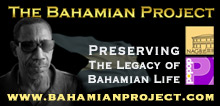Harry C. Moore Library Spotlight On Alistair Stevenson
Harry C. Moore Library And Information Center
Spotlight On Alistair D. Stevenson
Too often, art classes act in a “academic vacuum” says College of The Bahamas art instructor, John Cox. To give his advanced students experience in the local art world and to “breathe life into the art program” at the College of The Bahamas, he helps them plan and carry out site-specific art pieces.
The latest location is the new building at the College of The Bahamas, the state-of-the-art Harry C. Moore Library and Information Center — fitting since Harry C. Moore was a lifelong patron of the arts.
“I think a lot of people don’t know what a supporter of the arts he was and these pieces bring attention to it,” says Cox. “It presents a present and future effort to make the library a monument to contemporary visual expression.”

Alistair Stevenson. Photo by Tara Woodside
Over the next few weeks, Arts & Culture will be examining the installations in this library by his Art 400: Advanced Painting students.
On the second floor of the Harry C. Moore Library and Information Center, weaving along the space between windows, lies a test. It’s Alistair D. Stevenson’s installation “Contagious”, and it’s a veritable rorschach exercise—does the stained plywood drilled into a series of seven low-relief sculpture panels resemble a creature crawling along the wall? A relief map? A birds-eye-view of islands? Coral reefs?
There’s no doubt the shapes themselves are organic, something which the artist — who is completing his B.Ed in Art Education — aimed for. He’s hoping that students who sit in the space gain some appreciation for the beauty of nature and life as they take a brief break from their work to study the installation.
“In my work, I like organic forms and nature. I like the feel of an organic space in a refined environment,” Stevenson says.
“I’m not a huge ‘green’ person, but I think just to enjoy nature is important, especially in New Providence which is developing into a concrete jungle,” he continues.
“We don’t focus on nature so we don’t focus on the little wonders in life.”
But nature is both beautiful and destructive — a two-faced coin that Stevenson draws upon to create tension in the piece. Such abject pull is the very thing that draws its viewers in despite some underlying discomfort.
For in the end, these ink blot tests may prove not to resemble physical objects at all, but rather embodiments of decay, which in itself possesses the reminder of the passage of time.
Somewhat like a rusting hull, the piece transforms in each panel between windows, their holes becoming craters and falling away. The middle panel itself is almost entirely eaten away, suggesting some decay from the inside out—or a metaphor for change, as viewed linearly, the shape fills out again after melting away, seeming to recover.
With a title like “Contagious”, perhaps then the question posed to the viewer is this: Is the piece the infector or the infected? Is it the shifting amoeba, able to evolve in strength and intelligence to inhabit its hosts, or is it the host itself, the slow onslaught of disease becoming visible?
“My approach was to explore the metaphorical and literal meanings of the word contagious,” explains Stevenson. “In a literal sense, disease is so prevalent — our fear of it, washing hands and hand sanitizer — and just the fact that it’s spreadable causes phobia.”
Yet the piece acts as a social observation as well—the way human culture itself evolves as humans essentially, thought popular vote, invent and do away with the very objects of our world and the evolution of those objects. Think of fashion trends, for example, or the evolution of the computer, and factory farming or industrial farming. What’s “contagious” catches on, deemed so by popular culture.
“Metaphorically the concept concerns people and population — how we move from one area to another and how we unify or stand as individuals — how we ‘go with the flow’ or express ourselves as individuals,” he continues.
This aspect too, raises many points not just about the destructive tendencies of human nature, but the overarching realities of change, whether by time or my man’s hand.
In the end though, anything you may see in this piece has meaning. The beauty lies in that exercise of looking and recognizing the abstract and the abject, the reflection of the self.
“I would like people to see the message itself, but I like it when people can see themselves in the work,” says Stevenson. “When people can have a conversation about your work and find part of it they relate to, I enjoy that as an artist.”
As one of the participants in the Art 400 class that got to draft a proposal and design a piece for the library, Stevenson feels honored his work is seen by so many peers in a space dedicated to a man who believed in the arts.
“The fact that we were given an opportunity to put work in a space that honors a patron of art, as an artist myself it feels good. I imagine he’d be proud of us,” he says.
“What I enjoyed was the independence of working on it. In the end it was just great to experience working on this project,” he continues. “I think there’s a need to place sculpture into the environment — you can get people to enjoy nature in an area that lacks nature.”
Sonia Farmer
The Nassau Guardian
(Published in The Nassau Guardian, Arts & Culture, August 6th, 2011)
NOTE: Alistair is one of the three junior resident artists currently at Popopstudios.











